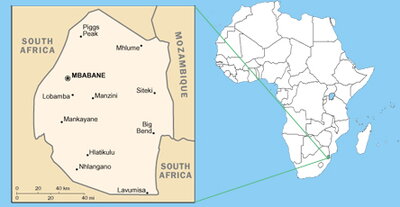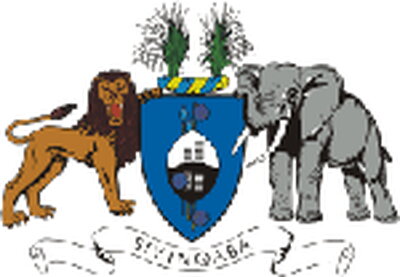

Region: Southern Africa
Quick Facts:
- Population: 1.1 million
- Capital: Mbabane
- Area: 6,704 sq miles (Slightly less than half the size of Alaska)
- Major Languages: English, Swazi
- Life Expectancy: 32 years (men), 33 years (women)
- Literacy: 81.6%
- Monetary unit: 1 Lilangeni (SZL)=100 cents
- Exchange Rate: US $1= 9.675 (SZL) (Jan 08, 2009 )
- Income (GDP) per capita: $5137 (constant 2000 international $, WDI 2005)
- Urban population: 59.3% of total population
- Paved roads: 20.3% of total road surface
- Electric Power Consumption (per capita): 1118 kWH
- Fixed line and mobile phone subscribers: 118 per 1,000 people
- Internet Users: 78 per 1,000 people
- Internet Domain: .sz
- Country Code: +268
- Time Difference: UTC+2 (8 hours ahead of Illinois during Standard Time.)
- Climate: Subtropical. Hottest months are January and February (59-77F ), coldest months are June and July (45-66F)
- Type of Government: Monarchy
- King: Mswati III
Historical Background:
Archeological evidence suggests that the earliest inhabitants of this region were the Khoisan hunter-gatherers. These people were displaced by Bantu-speaking groups who entered in the 12th century or earlier. The ruling Dlamini lineage had chiefships in the region in the 18th century. King Sobhuza I expanded the kingdom of Swaziland in the early nineteenth century, around the same time that the first whites settled in this area. After the South African war of 1899-1902, Swaziland became a British protectorate and eventually gained independence on September 6, 1968.
Socio-political Background:
The head of state is the king, currently King Mswati III, who ascended to the throne upon the death of his father King Sobhuza II in 1986. By tradition, the king reigns along with his mother, the former viewed as the administrative head of state and the latter as a spiritual and national head of state. As the monarch, the king not only appoints the prime minister who is the head of government, but also appoints a small number of representatives for both chambers of parliament. The Senate consists of thirty members, while the House of Assembly has sixty-five seats, fifty-five of which are occupied by elected representatives (elections are held every five years in November).
The constitution that was adopted in 1968 was suspended in 1973 in a State of Emergency decree. The State of Emergency has since been lifted. In 2001 King Mswati III appointed a committee to draft a new constitution. Drafts were released for comment in May 2003 and November 2004. However, they were strongly criticized by civil society organizations in Swaziland and human rights organizations elsewhere. In 2005, the constitution was put into effect, though there is still much debate in the country about that issue.
In 2004, Swaziland acknowledged for the first time that it suffered an AIDS crisis, with 38.8% of the population infected with HIV. Prime Minister Themba Dlamini declared a humanitarian crisis due to the combined effect of drought and land degradation, increased poverty, and HIV/AIDS.
Approximately 50,000 children have lost one or both parents as a direct result of AIDS, and 60 percent of hospital admissions are due to HIV/AIDS-related illnesses (www.usaid.gov ). The majority of deaths occur among young people aged 15-49, the nation’s most productive population segment. Particularly high infection rates of up to 47.3 percent are found among women 15-24 years of age, and up to 18.3 percent among men in the same age group. Life expectancy at birth in the mid-1990s was 51 years, but it has dropped rapidly as a direct result of AIDS. As at 2007, the adult prevalence rate of HIV/AIDS in Swaziland was 26.1 percent of the population, and 10 000 HIV/AIDS deaths were estimated for that year. There is also a very high risk of major infectious diseases, including hepatitis A, diarrhea, and malaria.
Economy:
A large percentage of the Swazi population lives in rural areas and is poor. The unemployment rate is approximately forty percent. Nearly seventy percent of the population lives on less than a dollar per day. The country has a very low Human Development Index (HDI) development score. Economic growth has wavered in the past few years, exacerbated by the economy's inability to create new jobs at the same rate that new job seekers enter the market. Overgrazing, soil depletion, drought, and floods are persistent problems. Meanwhile, King Mswati III is often strongly criticized for living so lavishly in such a poor nation. He has a fleet of luxury cars, and has spent millions towards refurbishing his numerous wives' luxury mansions.
In spite of these troubles, Swaziland enjoys relative economic success, perhaps due in part to its well-developed transportation links (road and train) to South Africa. A train line between Swaziland and the Port of Maputo in Mozambique allows the export of goods through the port. Similar links to the South African ports of Durban and Richards Bay facilitate trade with Swaziland.
Recently, a number of industrial firms have located at the industrial estate at Matsapha near Manzini. In addition to processed agricultural and forestry products, the fast-growing industrial sector at Matsapha also produces garments, textiles, and a variety of light manufactured products. The Swaziland Industrial Development Company (SIDC) and the Swaziland Investment Promotion Authority (SIPA) have assisted in bringing many of these industries to the country. Government programs encourage Swazi entrepreneurs to run small and medium-sized firms. Tourism also is important, attracting more than 424,000 visitors annually (mostly from Europe and South Africa).
Trade Information:
- Exports: $2.201 billion (2006 est.)
- Export Goods: Soft drink concentrates, sugar, wood pulp, cotton yarn, refrigerators, citrus and canned fruit
- Main Export Partners (2005): South Africa (59.7%), EU (8.8%), US (8.8%), Mozambique (6.2%) (2004)
- Imports: $2.274 billion (2006 est.)
- Import Goods: Motor vehicles, machinery, transport equipment, foodstuffs, petroleum products, chemicals
- Main Import Partners (2005): South Africa (95.6%,) EU (0.9%), Japan (0.9%)
Resources for Businesses:
Embassy of the Kingdom of Swaziland, Washington DC
1712 New Hampshire Av, NW
Washington, DC 20009
Tel: (202) 234 5002
Fax: (202) 234 8254
Email: info@swazilandembassyus.com

The International Trade Department of the Government of Swaziland (Government website)
P.O. Box 518
Mbabane, Swaziland
Tel: (268) 404 2661/2/3/4
Fax: (268) 404 2669
Email: ps_foreignaffairs@gov.sz
The Federation of Swaziland Employers & Chamber of Commerce (FSE&CC)
Last updated on 09/23/2009